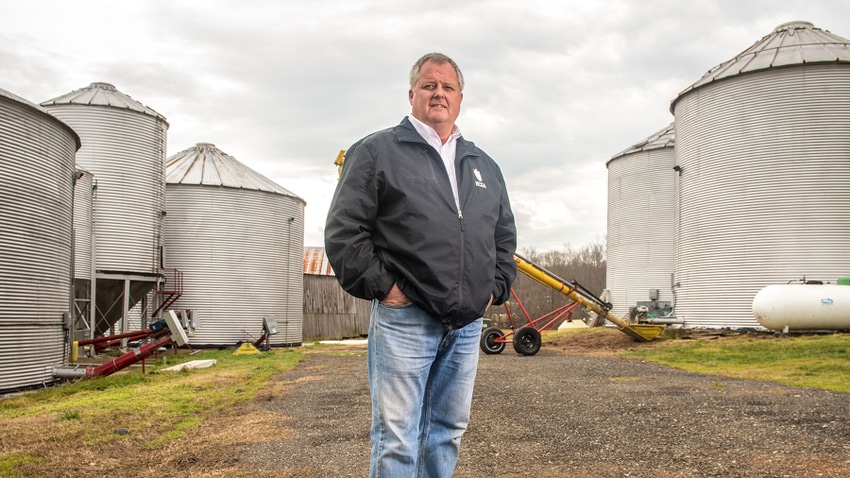
At a Glance
- In Ohio, Michigan and the Northeast, dicamba is allowed until June 30.
- The sale of dicamba products is allowed through May 31.
- There are options outside of dicamba, but effectiveness varies by weed.
Fifth-generation Ohio farmer Nathan Eckel says dicamba serves an important purpose on the farm in Perrysville he manages with his two brothers.
“It’s a really good tool, but that doesn’t mean we don’t need some clear-cut regulation,” he says. “We have had some drift issues in the past, but nothing we couldn’t get past with our neighbors — nothing catastrophic. It is a great preemergence tool to really give us that extra edge we always need, because who knows when that window of planting opportunity is going to be there?”
On Feb. 6, a federal court in Arizona vacated EPA’s 2020 registrations for dicamba products — XtendiMax, Engenia, Tavium and others — to be used in over-the-top applications in soybeans or cotton.
Then last week, EPA announced that it was allowing existing stocks of the herbicide to be used until June 30 in Ohio, Michigan, and all the Northeast and mid-Atlantic states. The sale and distribution of dicamba products will be allowed until May 31.

DICAMBA PIVOT: Ohio Wood County farmer Nathan Eckel says he plans to use Liberty in place of dicamba this year. (Photo courtesy of Eckel family)
Dicamba has been effective in controlling glyphosate-resistant broadleaf weeds, but its expanded use has increased the risk of drift damage.
Eckel, who is also vice president of the Ohio Soybean Council, said his farm turned to dicamba when it was having heavy marestail and waterhemp issues. “We haven't taken Roundup out of the equation yet, but dicamba did fill that gap with Roundup escapes we were having,” he says.
He and his brothers farm 2,000 acres of corn, soybeans and wheat, and raise 900 head of beef cattle. They have applied dicamba on about 900 acres of soybeans the past four years.
Last year, they scaled back, using it primarily as a preemergence application. “And if we had a bad escape of weeds, we would use it on a case-by-case basis,” Eckel adds. “It was nice to have that tool in the toolbox.”
Eckel says he is pivoting and combating herbicide resistance in soybeans by spraying Liberty. He still plans on using dicamba as a preseason burndown, which is still allowed as the ban prohibits over-the-top postemergence applications.
What’s the biggest impact? He says it comes down to the availability and cost of Liberty. “Are they going to jack up the price of Liberty because they know we’re not able to use dicamba in-season, as in years past?” Eckel asks.
And like most farmers, Eckel says he would have preferred a heads-up before buying inputs for the season.
“At the end of the day, it’s the federal government suing the federal government over not doing their due diligence,” he says. “So, who knows how long that'll take before they actually figure out who's at fault? Once again, as a farmer, we're caught in the middle … in the crossfire.”
What’s next?
Newburg, Md., grower Chip Bowling spent much of his postharvest period planning for the 2024 growing season.
As dicamba has been a godsend on his farm, he planned on going 100% Xtend and XtendFlex soybeans for the coming growing season. He preordered all his soybeans and chemicals months ago.
“I had been getting really good results using dicamba, especially on Palmer amaranth,” Bowling says. “Eight or nine years ago, I had a terrible outbreak of it, and dicamba really helped clean it up.”
Knowing the dicamba lawsuit was in court, he had a Plan B for his farm. He considered switching some of his 1,100 acres of soybeans to Enlist varieties, which are also tolerant to multiple herbicides but aren’t engineered to be tolerant to dicamba — instead, 2,4-D.
“It wasn't like it caught us flat-footed,” Bowling says. “We had been planning on a Plan B since late last fall. I knew that it was in court. You kind of have a gut feeling of how things are going to go. You just hear murmurs in the industry about how things were going to end up.”
And while he still plans on using dicamba this season, he’s uncertain about the future, and that makes him nervous. His concern is, what’s next? A ban on glyphosate? A ban on certain seed treatments?
“What concerns me is you have lawmakers and politicians that make their decisions based on emotion rather than science and data,” Bowling says. “That’s where we spend our time trying to educate people, because the results aren’t going to affect them at all.”
It’s also a concern for Lindsay Thompson, executive director of Maryland Grain Producers.
“We’re seeing pesticide decisions made in legislatures and courts not based on science,” Thompson says.

NEW RULES: On Feb. 6, a federal court in Arizona vacated EPA’s 2020 registrations for dicamba products — XtendiMax, Engenia, Tavium and others — to be used in over-the-top applications in soybeans or cotton. Then last week, EPA announced that it was allowing existing stocks of the herbicide to be used until June 30 in Ohio, Michigan, and all the Northeast and mid-Atlantic states. The sale and distribution of dicamba products will be allowed until May 31. (JJ Gouin/Getty Images)
The Federal Insecticide, Fungicide, and Rodenticide Act is the federal statute that governs the registration, distribution, sale and use of pesticides and herbicides in the U.S.
Thompson says many legislatures have gone outside the FIFRA regulatory framework to make their own regulations to either ban or severely scale back the use of certain chemicals on farms.
Cory Chelko, East Coast product manager for Revere Seed, says the Arizona court’s decision left an unworkable timeline for growers who then had to decide whether to go with Enlist or do something else.
“The XtendFlex and Enlist soybeans that we offer both come with compelling genetic performance, but our growers have selected the varieties they did for specific reasons — be it herbicide choice, disease tolerances, standability, plant type, etc.,” Chelko says.
“Since the ruling … we are recommending growers who plant XtendFlex soybeans start clean, be prepared for an early post spray with a chemistry targeted to their weed pressure, use glyphosate and glufosinate as needed, and practice overall good IPM techniques. Those recommendations apply to our customers utilizing the Enlist soybean platform as well.”
For his part, Bowling says he uses dicamba according to the product label and does not skimp on additives to help reduce drift.
He also farms in an area that’s close to thousands of homes, so he knows that if a neighbor’s plants were damaged by something, they could easily blame him for it.
“You hate to lose the availability of a new chemical that works,” Bowling says. “If it is used properly, it could be maintained in a way that you wouldn’t have to stop using it, in my opinion.”
Alternatives to dicamba
Below are some dicamba alternatives put together by Dwight Lingenfelter, Extension associate of weed science at Penn State:
Glyphosate (group 9). Used in Roundup Ready systems, this is a viable option to control many weeds. But it will not control glyphosate-resistant weeds such as marestail, Palmer amaranth and waterhemp.
In a standard Roundup Ready system, a two-times rate (1.5 pounds acre equivalent) of glyphosate or a couple of in-crop applications of glyphosate will usually stunt marestail. It is always best to treat it right after it starts regrowing from burndown. This will not control it, but it may suppress it somewhat if it’s sprayed early enough.
Also, remember that marestail plants are not very tolerant of shade. Most soybeans will canopy over marestail and outcompete it.
ALS herbicides (group 2). Pursuit, Raptor, Classic, Harmony and FirstRate can still provide control of several broadleaf weeds. However, ALS-resistant marestail and pigweeds are common.
Classic controls cocklebur, smartweed and burcucumber, and it provides suppression of certain perennials such as bindweed and pokeweed. Harmony is effective on lambsquarters, smartweed and velvetleaf.
FirstRate controls cocklebur, annual morningglory and ragweed. Pursuit and Raptor are good on cocklebur, eastern black nightshade and velvetleaf, as well as annual grasses. These herbicides can be used in conventional or GM soybeans.
PPO herbicides (group 14). Reflex, Flexstar, Cobra, Ultra Blazer, Cadet and other group 14s have activity on certain broadleaves. But keep in mind, not all of them have the same effectiveness on all broadleaf weeds.
For example, Reflex/Flexstar, Cobra and Ultra Blazer provide good control of pigweeds, including Palmer amaranth and waterhemp, and can suppress ragweed and eastern black nightshade, but they have limited activity on marestail and are weak on lambsquarters.
Cadet is great on velvetleaf but weak on other species, including pigweeds, lambsquarters, ragweed, cocklebur and marestail. In general, the pre-PPOs (Valor, Authority, etc.) are effective on both marestail and Palmer amaranth and waterhemp. Any of these PPO herbicides can be used in conventional or GM soybeans.
Glufosinate (group 10). The active ingredient in Liberty, Cheetah, Interline, Scout and other generics, this can be used over the top in LibertyLink, Enlist E3 or other glufosinate-resistant soybean varieties. It controls marestail, Palmer, waterhemp, cocklebur, lambsquarters, ragweed and others.
Acetamide herbicides (group 15). Dual, Zidua/Anthem Maxx, Outlook, Warrant and a few others do not control existing weeds, but these should be included in the post-spray mix to provide “overlapping residual” control of weeds such as Palmer amaranth and waterhemp. These weeds have a prolonged germination period during summer, and residual products will be necessary for adequate control throughout the season.
Premixed products such as Prefix or Warrant Ultra are also available.
Remember, Enlist E3 soybeans are not affected by this lawsuit, and registered 2,4-D choline products such as Enlist One and Duo can be used in that system. These 2,4-D products cannot be used in XtendFlex soybeans. Otherwise, major crop damage will occur.
Enlist One provides control of several common broadleaf weeds, while Enlist Duo controls both broadleaves and grasses.
Read more about:
DicambaAbout the Author(s)
You May Also Like








